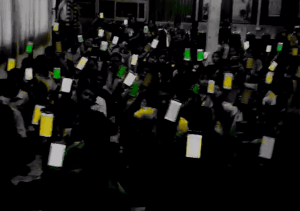Similarly to です (desu), ます (masu) is used to end a sentence politely. When the last word of a sentence is a verb, the verb can be changed from plain-form to ます-form.
ます-Form: Future, Past, Negative tenses
First of all, see an example of a verb in ます-form below.
In most cases, ending with ます is the future tense, not the present one. It is different from です. You can compare to English, when you are eating, you would say “I’m eating,” not “I eat”. Talking about present actions in Japanese is more complicated and will be discussed late.
Plain-Form
Some Japanese learners wonder why they cannot search for verbs in ます-form in the dictionary. The answer is that ます-form is not an original form of the verb—it’s a polite form. An original form is the Plain-form or so-called the dictionary-form.
Language teachers usually teach Japanese by starting from ます-form; going to various tenses from ます-form are much more simple than from plain-form, and ます-form can be used in most situation.
Plain-Form to ます-Form
Plain-form of verb ends with “u” sound, such as う (u), く (ku), る (ru). This form will be changed to ない-form for negative tense, and た-form for past tense. Here, you will learn basic transformation for changing plain-form verbs to their ます-Form.
There are 3 types of verbs in Japanese, see rules for their transformation.
Examples
The difficulty is in reversed order, therefore, we will start from Type 3.
Type 3: Verbs in this type ends with する (suru), which means “to do”. We can add する to a noun to make it become a verb, For example, 勉強 (benkyou) = studying (N) → 勉強する (benkyou suru) = do study (Verb), する will be changed to to します (shimasu) for ます-form. In ます-form, we can follow conversions in the first table to change the tense, for example, 勉強しませんでした (benkyou shimasen deshita) = I did not study.
The special verb of this type is 来る (kuru), which means “to come.” It’s ます-form is 来ます (kimasu).
More examples
- 散歩 (sampo) = walking/strolling (N) → 散歩する (sanpo suru) → 散歩ます (sanpo shimasu) = take a walk
- 旅行 (ryokou) = traveling (N) → 旅行する (ryokou suru) → 旅行します (ryokou shimasu) = travel
Type 2: Verbs ending with eる (eru) are in this type. They can be transformed into ます-form by changing the ending る to ます. It is noted that, when a verb is written in Kanji, a character with the e-sound must be in Hiragana.
Type 2 also includes irregular verbs, which are those not ending with eる but will be converted in the same manner, e.g., ある → あります
For examples
- 食べる (taberu) → 食べます(tabemasu) = eat,
- 疲れる (tsukaeru) → 疲れます(tsukaemasu) = get tired
- 浴びる (abiru) → 浴びます(abimasu) = take a bath
Type 1: The remaining verbs are in this type. The ending u-sound will be changed to i-sound and then connected with ます.
For examples
- 買う (kau) → 買います (kaimasu) = buy
- 取る (toru) → 取ります (torimasu) = pick up / collect / get
- 貸す (kasu) → 貸します (kashimasu) = lend
- 帰る (kaeru) → 帰ります (kaerimasu) = return **e is not in Hiragana
Learn Vocabulary
https://www.youtube.com/playlist?list=PLB3Mq8bM3diGTsTlV2LrCtxF12bHIwgA8







